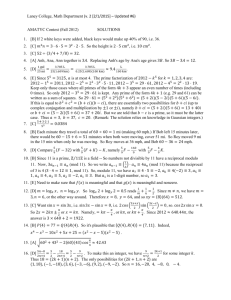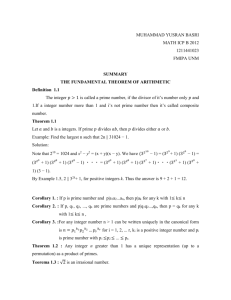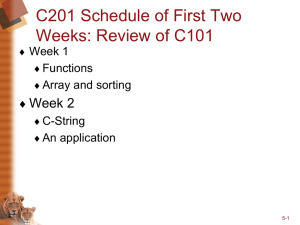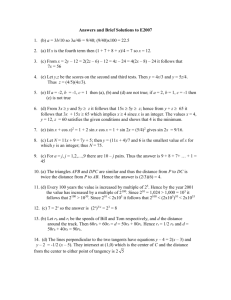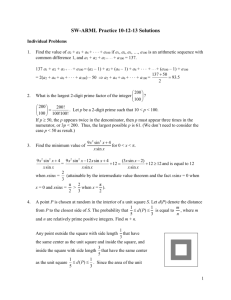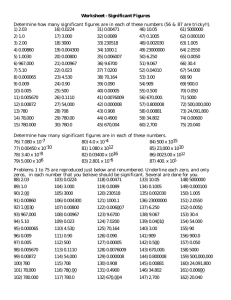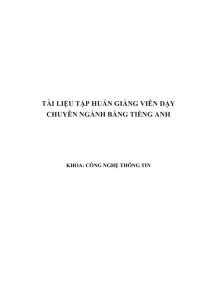Solutions - Missouri State University
advertisement
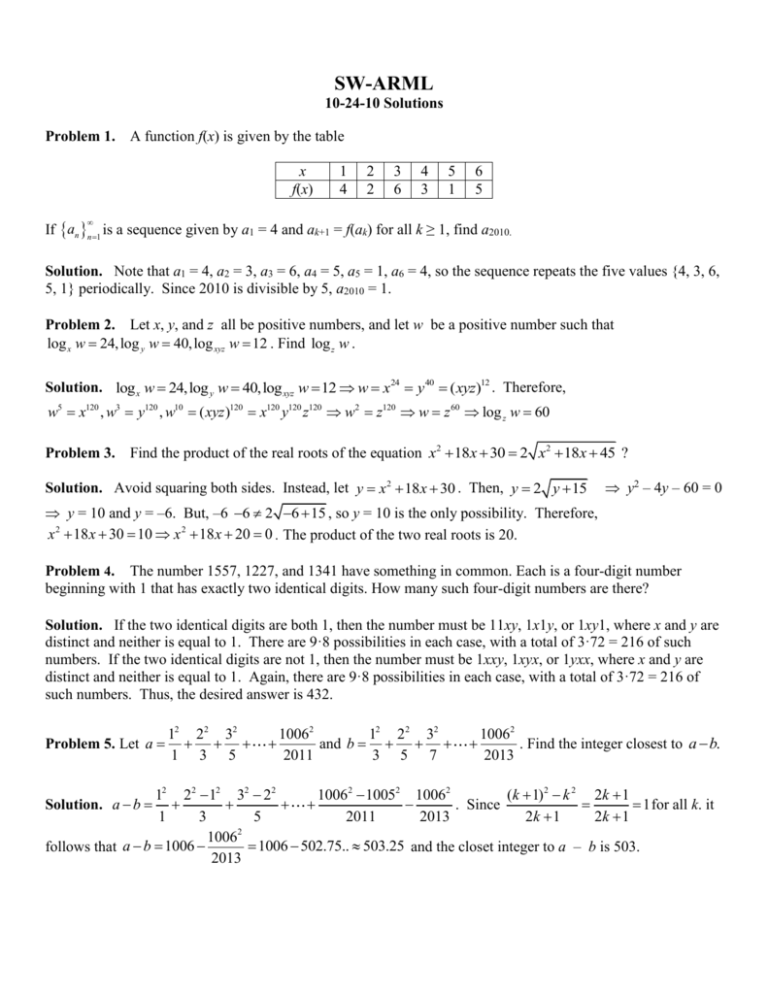
SW-ARML
10-24-10 Solutions
Problem 1. A function f(x) is given by the table
x
f(x)
1
4
2
2
3
6
4
3
5
1
6
5
If an n 1 is a sequence given by a1 = 4 and ak+1 = f(ak) for all k ≥ 1, find a2010.
Solution. Note that a1 = 4, a2 = 3, a3 = 6, a4 = 5, a5 = 1, a6 = 4, so the sequence repeats the five values {4, 3, 6,
5, 1} periodically. Since 2010 is divisible by 5, a2010 = 1.
Problem 2. Let x, y, and z all be positive numbers, and let w be a positive number such that
log x w 24, log y w 40, log xyz w 12 . Find log z w .
Solution. log x w 24,log y w 40,log xyz w 12 w x24 y 40 ( xyz)12 . Therefore,
w5 x120 , w3 y120 , w10 ( xyz )120 x120 y120 z120 w2 z120 w z 60 log z w 60
Problem 3. Find the product of the real roots of the equation x2 18x 30 2 x2 18x 45 ?
Solution. Avoid squaring both sides. Instead, let y x 2 18 x 30 . Then, y 2 y 15
y2 – 4y – 60 = 0
y = 10 and y = –6. But, –6 6 2 6 15 , so y = 10 is the only possibility. Therefore,
x 2 18 x 30 10 x 2 18 x 20 0 . The product of the two real roots is 20.
Problem 4. The number 1557, 1227, and 1341 have something in common. Each is a four-digit number
beginning with 1 that has exactly two identical digits. How many such four-digit numbers are there?
Solution. If the two identical digits are both 1, then the number must be 11xy, 1x1y, or 1xy1, where x and y are
distinct and neither is equal to 1. There are 9·8 possibilities in each case, with a total of 3·72 = 216 of such
numbers. If the two identical digits are not 1, then the number must be 1xxy, 1xyx, or 1yxx, where x and y are
distinct and neither is equal to 1. Again, there are 9·8 possibilities in each case, with a total of 3·72 = 216 of
such numbers. Thus, the desired answer is 432.
12 22 32
Problem 5. Let a
1 3 5
10062
12 22 32
and b
2011
3 5 7
10062
. Find the integer closest to a b.
2013
12 22 12 32 22
10062 10052 10062
(k 1)2 k 2 2k 1
1 for all k. it
. Since
1
3
5
2011
2013
2k 1
2k 1
10062
1006 502.75.. 503.25 and the closet integer to a – b is 503.
follows that a b 1006
2013
Solution. a b
Problem 6. How many zeros does the number
2010!
1005!
2
end?
Solution. The number of zeros at the end of n! is the largest power of 10 that si a factor of n!. It is also the
largest power of 5 that divides n! In general the largest power of the prime p in the prime factorization of n! is
n ! n ! n !
p p 2 p 3 , where [x] is the greatest-integer function. Therefore, the largest power of 5 that
divides
2010 2010 2010 2010
2010!
1005!
2
1005 1005 1005 1005
is
2
5 25 125 625
5 25 125 625
= 402 + 80 +16 + 3 – 2(201 + 40 + 8 + 1) = 1.
Problem 7. Find the minimum value of
9 x 2 sin 2 x 4
for 0 < x < .
x sin x
9 y2 4
4
Solution. Let y = xsin x > 0 and rewrite the given expression as
9 y . The Arithmetic Meany
y
4
9y
4
4
y
9 y 6 9 y 12 (= 12 when y =
Geometric Mean Inequality implies that
2
y
y
2
9 x 2 sin 2 x 4
4
2
9 y , y ) . The minimum value of
is 12 (when x sin x which can be attained by the
3
x sin x
y
3
Intermediate Value Theorem., since 0 xsinx /2 on the interval [0, /2].
200
What is the largest 2-digit prime factor of the integer
?
100
200
200!
Solution.
. We are looking for a prime 10 < p < 100. The factor of p appears twice in the
100 100!100!
denominator, so we’ll need it to appear in the numerator three times, or 3p 200, implying p = 61.
Problem 8.
Problem 9.
Let an n 1 be given by an 6n 8n all n ≥ 1. Find the remainder upon dividing a2010 by 49.
Solution. 62010 82010 (7 1)2010 (7 1)2010 2(72010 72008
divisible by 49, so the remainder is 2.
72 1) . All but the last term are
Problem 10. Let n be the smallest positive integer that is a multiple of 75 and has exactly 75 positive integer
n
divisors, including 1 and itself. Find
.
75
Solution. In general, if the prime factorization of n is n p1a p2b p3c
, then n has exactly (a 1)(b 1)(c 1)
divisors, including 1 and itself. Sine 75 = 3·52 = 3·5·5 and 75 divides n, two of n’s prime factors are 3 and 5.
To minimize n, we can introduce a third prime factor, 2. Also, we need the factor 5 to be raised the least power.
n 243452
16 27 432 .
therefore, 2434and 52 is the smallest possible. The desired answer
75 3 52

